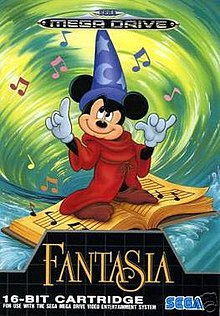Fantasia (video game)
This article needs additional citations for verification. (September 2012) |
| Fantasia | |
|---|---|
 European cover | |
| Developer(s) | Infogrames |
| Publisher(s) | Sega |
| Composer(s) | Frederic Metzen |
| Platform(s) | Mega Drive/Genesis |
| Release | November 1991 (NA, EU, JP)[1] |
| Genre(s) | Platform |
| Mode(s) | Single-player |
Fantasia (ファンタジア ミッキーマウス・マジック, lit. "Fantasia: Mickey Mouse Magic") is the title of a side-scrolling video game developed by Infogrames and produced by Sega for its own Mega Drive/Genesis system. The game was loosely based on the film of the same name.
Plot[]
"While the Apprentice Sorcerer slept his master's music was stolen away. Now his dreams must restore the notes so the music can play again."
Gameplay[]
In the game, the player controls Mickey Mouse as the Sorcerer's Apprentice through various side-scrolling levels in an attempt to collect musical notes that somehow went missing whilst he was asleep.[1] The game's four levels were based on amalgamations of the segments of Fantasia, with each one themed around the elements: water (The Sorcerer's Apprentice, Dance of the Reed Flutes and Arabian Dance), earth (The Rite of Spring), air (Russian Dance, Pastoral Symphony and Dance of the Hours) and fire (Night on Bald Mountain, Toccata and Fugue in D Minor). The player defeats various enemies by jumping on them or by collecting magical bubbles that could be used to shoot at enemies as projectiles. In each level, the player collects a certain number of hidden magical notes in order for the song to play once again.
Development[]
Sega was inspired by the success of Castle of Illusion and by the 50th Anniversary of the 1940 film to create the game. Development began as early as January 1990.[2] The Sega producer Scott Berfield along with Stephan L. Butler monitored Infogrames development of the game to ensure it remained a faithful adaptation. The development team consisted of six people who lacked experience in developing console games.[1]
With pressure from Holiday Rush and the summer release of Sonic the Hedgehog, time to develop the game was tight. It was difficult to replicate the animation and music quality of the film to the 16-bit console.[1] By May, Sega presented Fantasia at the Consumer Electronics Show and by mid-summer was showcased at the Tec Toy launch.[3]
With no time to tweak the gameplay or polish the graphics, the game was shipped in time for the Holiday season. Unfortunately, the release of Fantasia was met with complaints by Roy E. Disney who had made a promise to his uncle Walt, that Fantasia adaptions would not be made. The licensing turned out to be granted in error. Sales of the game were to stop, every unsold copy (5,000 approximately) was to be destroyed and every advertisement about the game was to be removed.[1]
Reception[]
The game was poorly received, with MegaTech magazine saying the game was "a massive disappointment. Poorly designed, bland and frustrating, with very little appeal". Mean Machines said that although appearing impressive at first with "excellent sprites and gorgeous backdrops", "the gameplay is badly flawed and there are several highly annoying features that make the action frustrating."[6] Mega placed the game at #6 in their list of the 10 Worst Mega Drive Games of All Time.[7]
See also[]
- List of Disney video games by genre
References[]
- ^ a b c d e 1973-, Horowitz, Ken (21 October 2016). Playing at the next level : a history of American Sega games. Jefferson, North Carolina. ISBN 9780786499946. OCLC 948561018.CS1 maint: numeric names: authors list (link)
- ^ "Sega for the 90s". . Vol. 8 no. 10. January 1990. p. 14.
- ^ "The Planet Disney enters the orbit of Sega" (PDF). Supergame. No. 2. August 1991. pp. 20–23.
- ^ "Fantasia - MegaTech". MegaTech. No. 6. EMAP. June 1992. p. 77.
- ^ "Fantasia - Mega Rating". Mega. No. 20. Future Publishing. May 1994. p. 65.
- ^ "Fantasia - Meacn Machine Review" (PDF). Mega. No. 12. Future Publishing. September 1991. pp. 54–56.
- ^ "Fantasia - Mega Review". Mega. No. 1. Future Publishing. October 1992. p. 85.
External links[]
- Fantasia (franchise)
- 1991 video games
- Dinosaurs in video games
- Fantasy video games
- Mickey Mouse video games
- Infogrames games
- Platform games
- Single-player video games
- Sega Genesis games
- Sega Genesis-only games
- Side-scrolling video games
- Video games based on films
- Video games developed in France
- Video games set in prehistory